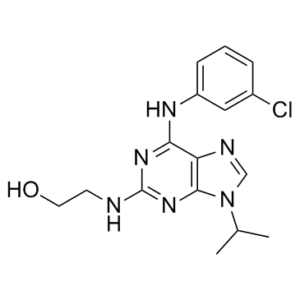NG 52 (NG-52), a tri-substituted purine, is a cell-permeable, reversible, and ATP-competitve inhibitor of the cell cycle-regulating kinase, Cdc28p with IC50 of 7 μM, and the related Pho85p kinase with IC50 of 2 μM. NG-52 inhibits Cdc28p and Pho85p by attaching to the ATP-binding site of yeast cyclin-dependent kinases.
Physicochemical Properties
| Molecular Formula | C16H19CLN6O |
| Molecular Weight | 346.81466 |
| Exact Mass | 346.13 |
| Elemental Analysis | C, 55.41; H, 5.52; Cl, 10.22; N, 24.23; O, 4.61 |
| CAS # | 212779-48-1 |
| Related CAS # | 212779-48-1 |
| PubChem CID | 2856 |
| Appearance | White to off-white solid powder |
| Density | 1.4±0.1 g/cm3 |
| Boiling Point | 587.7±60.0 °C at 760 mmHg |
| Flash Point | 309.2±32.9 °C |
| Vapour Pressure | 0.0±1.7 mmHg at 25°C |
| Index of Refraction | 1.688 |
| LogP | 1.54 |
| Hydrogen Bond Donor Count | 3 |
| Hydrogen Bond Acceptor Count | 6 |
| Rotatable Bond Count | 6 |
| Heavy Atom Count | 24 |
| Complexity | 401 |
| Defined Atom Stereocenter Count | 0 |
| SMILES | ClC1=CC(NC2=NC(NCCO)=NC3=C2N=CN3C(C)C)=CC=C1 |
| InChi Key | XZEFMZCNXDQXOZ-UHFFFAOYSA-N |
| InChi Code | InChI=1S/C16H19ClN6O/c1-10(2)23-9-19-13-14(20-12-5-3-4-11(17)8-12)21-16(18-6-7-24)22-15(13)23/h3-5,8-10,24H,6-7H2,1-2H3,(H2,18,20,21,22) |
| Chemical Name | 2-[[6-(3-chloroanilino)-9-propan-2-ylpurin-2-yl]amino]ethanol |
| Synonyms | NG 52; NG52; NG-52; Compound 52 |
| HS Tariff Code | 2934.99.9001 |
| Storage |
Powder-20°C 3 years 4°C 2 years In solvent -80°C 6 months -20°C 1 month |
| Shipping Condition | Room temperature (This product is stable at ambient temperature for a few days during ordinary shipping and time spent in Customs) |
Biological Activity
| Targets | cdc2-cyclin B (IC50 = 0.34 μM); Pho85p (IC50 = 2 nM); Cdc28p (IC50 = 7 μM); Phosphoglycerate kinase 1 (PGK1) (IC50 = 2.5 μM) |
| ln Vitro | NG 52 (Compound 52) stops drug-sensitized S cells from growing. strains of cerevisiae that have a 30 μM GI50. With an IC50 value of 340 nM, NG 52 has activity against cdc2-cyclin B[1]. While primary astrocyte proliferation is efficiently inhibited, NG 52 dose-regulatedly decreases the GI50 values of neuroastrocytoma U87 and U251 cell lines to 7.8 μM and 5.2 μM, respectively [2]. In U87 and U251 cells, NG 52 (12.5-50 μM) efficiently suppresses the phosphorylation of PDH at Ser293 and PDHK1 at Thr338. This increases the amount of pyruvate that enters the Krebs cycle, which in turn increases ATP and ROS. manufacturing[2]. By suppressing the activity of PGK1, NG 52 increases the activity of pyruvate dehydrogenase (PDH), which reverses the Warburg effect and shifts oxygen-assisted cells from anaerobic to aerobic mode [2]. |
| ln Vivo | Neuronal tumor xenograft growth is inhibited by dose-regulated NG 52 (50-150 mg/kg; basal; daily; for 13 days) [2]. |
| Cell Assay |
Cell proliferation assay [2] Cell Types: Glioma U87 and U251 Cell Tested Concentrations: 0 μM, 12.5 μM, 25 μM, 50 μM Incubation Duration: 6 days Experimental Results: Effectively inhibited the proliferation of primary glioma cells. Western Blot Analysis [2] Cell Types: glioma U87 and U251 cells Tested Concentrations: 0 μM, 12.5 μM, 25 μM, 50 μM Incubation Duration: 12 hrs (hours) or 24 hrs (hours) Experimental Results: Effectively inhibited the proliferation of primary glioma cells. |
| Animal Protocol |
Animal/Disease Models: Female nu/nu (nude) mice (5-week old) injected with glioma cells [2] Doses: 50 mg/kg, 100 mg/kg, 150 mg/kg Route of Administration: oral; daily; continued for 13 Day Experimental Results: Dose-dependent inhibition of glioma xenograft growth. |
| References |
[1]. Exploiting chemical libraries, structure, and genomics in the search for kinase inhibitors. Science. 1998 Jul 24;281(5376):533-8. [2]. Pharmacologically inhibiting phosphoglycerate kinase 1 for glioma with NG52. Acta Pharmacol Sin. 2020 Jul 31. |
Solubility Data
| Solubility (In Vitro) |
DMSO: 69~75 mg/mL (199~216.3 mM) Ethanol: ~23 mg/mL (~66.3 mM) |
| Solubility (In Vivo) |
Solubility in Formulation 1: ≥ 2.5 mg/mL (7.21 mM) (saturation unknown) in 10% DMSO + 40% PEG300 + 5% Tween80 + 45% Saline (add these co-solvents sequentially from left to right, and one by one), clear solution. For example, if 1 mL of working solution is to be prepared, you can add 100 μL of 25.0 mg/mL clear DMSO stock solution to 400 μL PEG300 and mix evenly; then add 50 μL Tween-80 to the above solution and mix evenly; then add 450 μL normal saline to adjust the volume to 1 mL. Preparation of saline: Dissolve 0.9 g of sodium chloride in 100 mL ddH₂ O to obtain a clear solution. Solubility in Formulation 2: ≥ 2.5 mg/mL (7.21 mM) (saturation unknown) in 10% DMSO + 90% Corn Oil (add these co-solvents sequentially from left to right, and one by one), clear solution. For example, if 1 mL of working solution is to be prepared, you can add 100 μL of 25.0 mg/mL clear DMSO stock solution to 900 μL of corn oil and mix evenly. (Please use freshly prepared in vivo formulations for optimal results.) |
| Preparing Stock Solutions | 1 mg | 5 mg | 10 mg | |
| 1 mM | 2.8834 mL | 14.4171 mL | 28.8342 mL | |
| 5 mM | 0.5767 mL | 2.8834 mL | 5.7668 mL | |
| 10 mM | 0.2883 mL | 1.4417 mL | 2.8834 mL |
